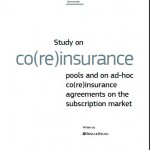 The long awaited Ernst & Young study on co(re)insurance pools and on ad-hoc co(re)insurance agreements on the subscription market was released in February.
The long awaited Ernst & Young study on co(re)insurance pools and on ad-hoc co(re)insurance agreements on the subscription market was released in February.
On 12 March 2013, members of the FERMA team attended the workshop organised by the European Commission to present the main findings of the study to insurance and risk management industry stakeholders.
The research is part of the preparation of the Commission for discussions on the Insurance Block Exemption Regulation (BER), which expires in its current version on 31 March 2017.
The Commission wants to get a better understanding of existing pools in the EU and to assess whether these pools fully comply with the block exemption from EU competition rules. The study was intended to be descriptive and does not seek to make recommendations.
The conclusions of the report – which in full is 645 pages – will not surprise members of FERMA. Although a previous study expressed concern that an alignment of premiums among co-(re)insurers might be the result of agreements or concerted practices between underwriters, the E&Y research did not identify any such collusion.
Yes, it did find that pool premiums were generally consistent with those charged by the leader, but the competition had simply taken place at an earlier stage.
Respondents indicated there was intense competition in the market for the selection of the leader and, therefore, for the initial determination of premiums, “such that there is no further efficiency to be squeezed out of the following market.”
The report continued: “On this analysis, even though there is no constraint on seeking further reduction from individual (re)insurers in the following market, the marginal benefits that might be achieved are perceived to be less than the frictional costs of seeking them, and alignment of premiums reflects an equilibrium.”
FERMA says
For the past five years, FERMA has consistently reminded the European authorities that the exemption from the application of EU competition rules provides more benefits than issues for the market. Some pools at national levels are really needed where the traditional insurance market is not interested or cannot solve a market problem on its own. This can be for unusual risks, terrorism or natural catastrophes for example, or for specific activities, such as marine liability and nuclear power.
Co-(re)insurance is also under scrutiny by the European Commission, but it is clear for FERMA that this practice is part of the basic functioning of the insurance market in Europe. It has been working properly for years, ensuring that large risks can find sufficient coverage, and should be allowed to continue without further obstacles.
For the insured and the broker, this practice saves precious time, avoiding heavy and complex individual negotiation with every possible coinsurer. It also brings legal certainty for the parties, making sure that terms and price are clear and consistent when it comes to handling claims and resolving disputes.
Subscription placement whether as insurance or reinsurance is not an obligation; insured and brokers remain free to negotiate and contract on an individual basis. This practice is just the most appropriate for all the parties involved.
Coinsurance business in Europe is attractive and competitive because of a world-recognised EU expertise. It is important to preserve these capabilities and ensure EU competitiveness with other coinsurance markets outside the European Union.
In a nutshell
Regulation
Block Exemption Regulation -BER-
Expires : 31 March 2017
Public consultation: 2015
Commission’s report: expected by 2016